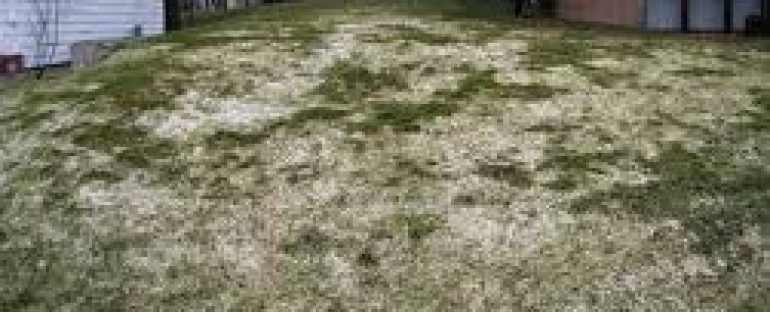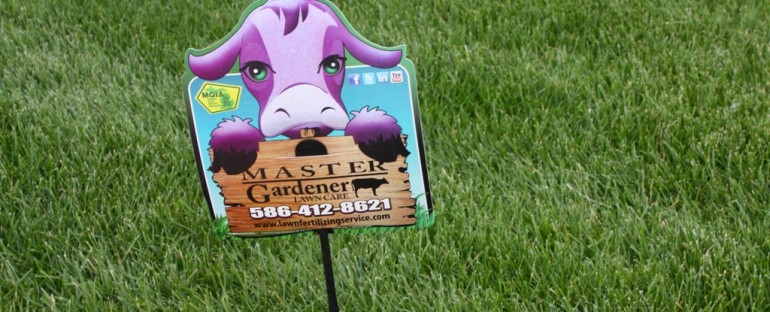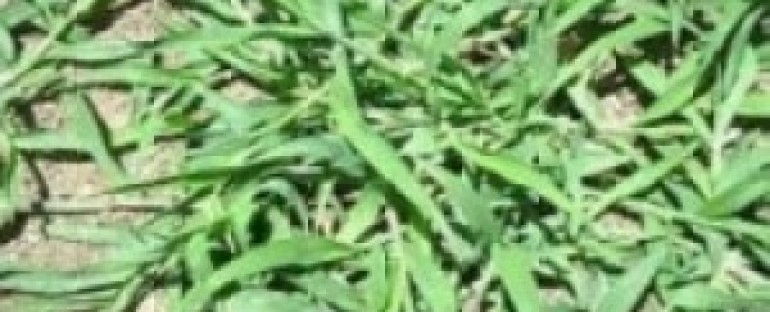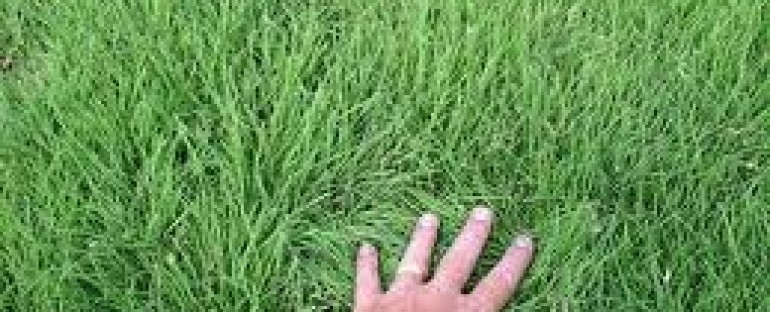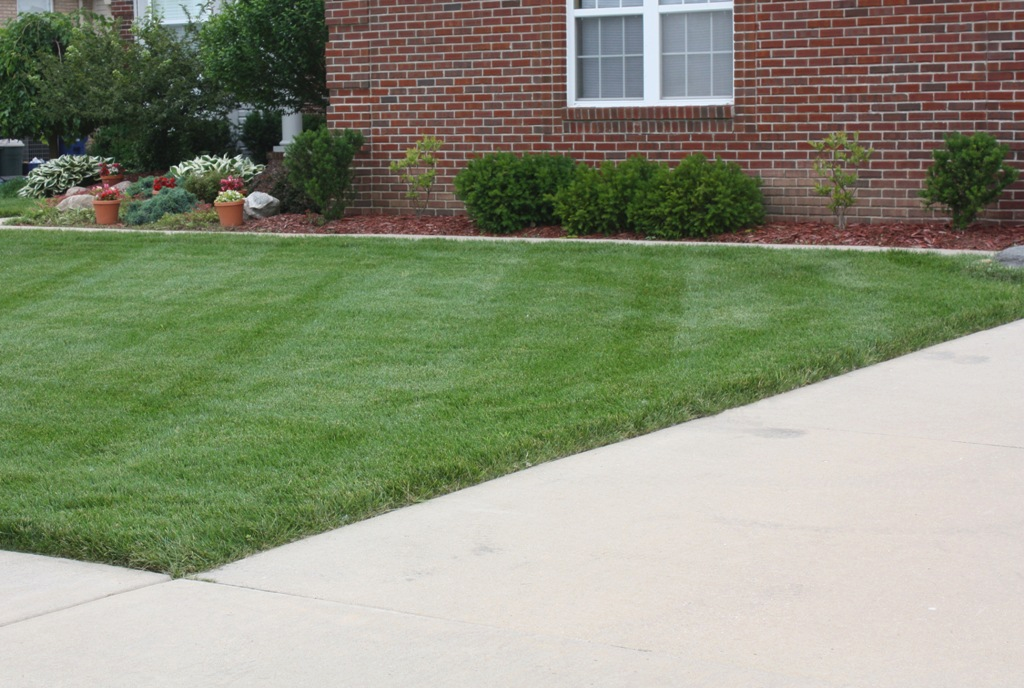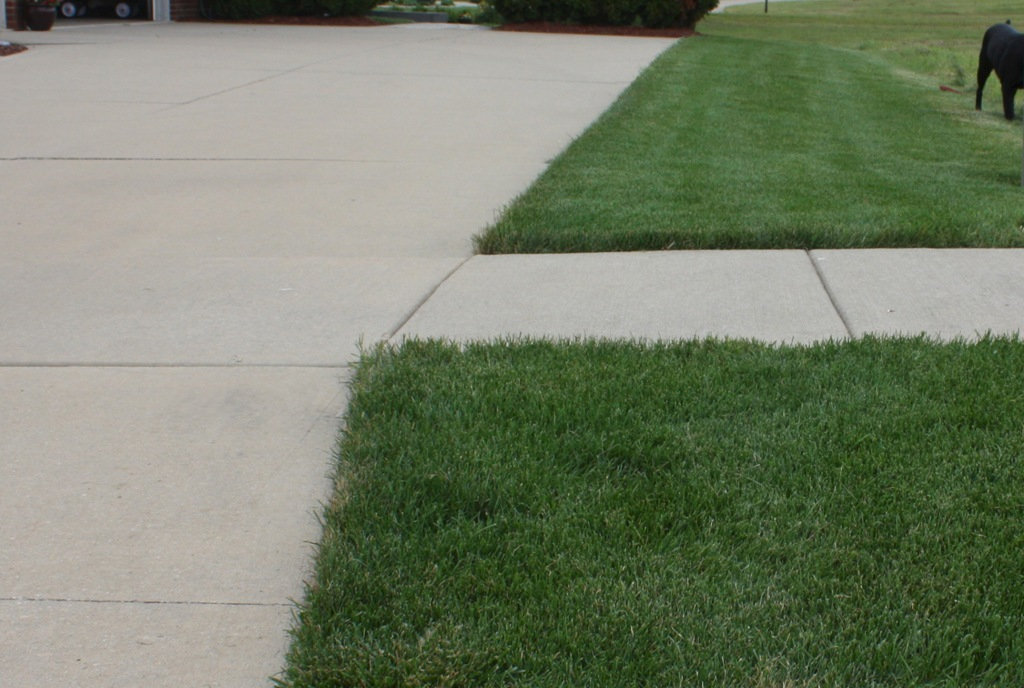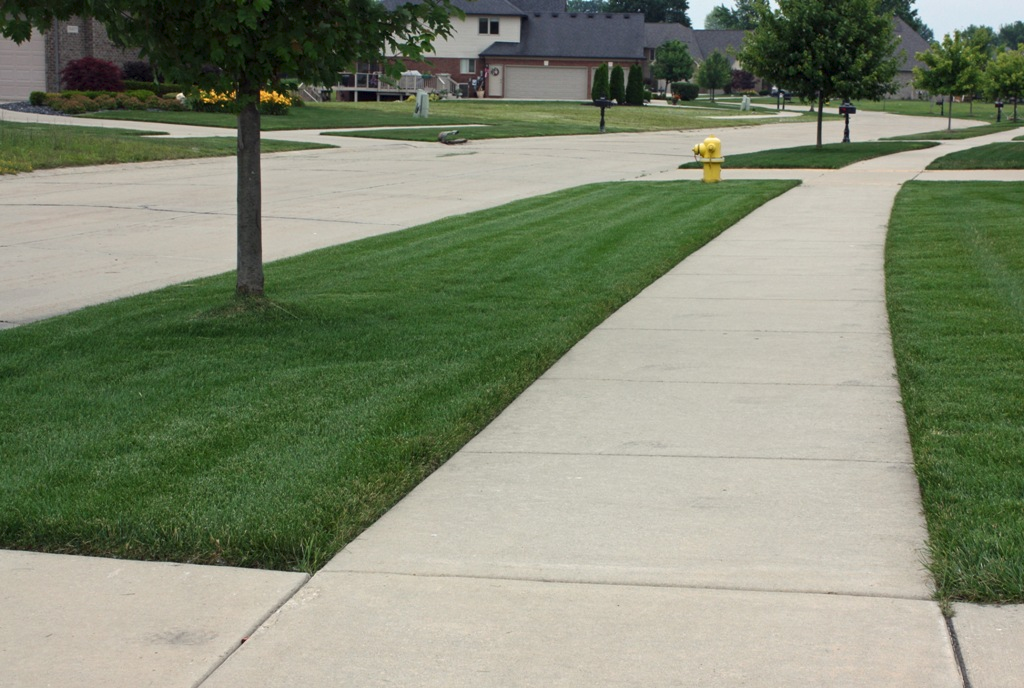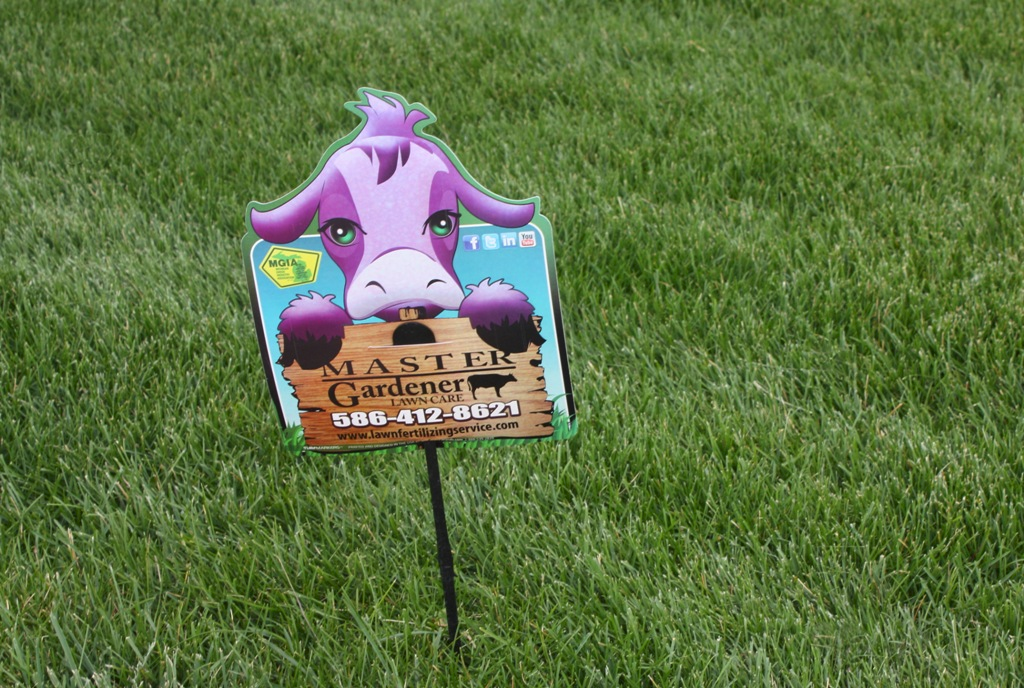Welcome to Master Gardener Award-Winning Lawn Fertilizing Service operating in Macomb County, Michigan
Tag Archives: lawn service
 When the Michigan snow melts in the next few weeks in Macomb and Berrien County you might be in for a surprise.  And that surprise is gray or pink snow mold. The good news is that in most cases these two issues won’t require much attention on your part. But Master Gardener Lawn Fertilizing Service will get calls from our clients and others asking us what is happening to their lawns. So we think it is important to talk about these snow molds. Gray Snow Mold is what we see most of in Macomb County and our Master Gardener Lawn Care location in Berrien County.  Like the name suggest it is recognized by the white to gray color. No need to worry!  This issue will clear up with the help of a little light raking. Just rake the affected area to allow the air to circulate and the snow mold will begin to diminish. Your first lawn fertilizing application will also help the process by providing nutrients to your lawn which help the turf to grow and recovery. Pink Snow Mold is little more serious of the two. It has a pink to salmon color. Again the first lawn fertilizing service application will stimulate the lawn to grow and the lawn should recover. Light raking of the damage turf will also help to speed up the recovery. There is more of a chance that pink snow mold damage may need to be over seeded.  Wait and see if your lawn recovers before taking any additional action. Please note that if you seed at this time you cannot apply a crabgrass pre-emergent. This pre-emergent will also prevent the grass seed from germinating. Read the label on the bag of the pre-emergent to see when it is safe to apply without interfering with the germination of the grass seed. Note: It is possible to see both gray and pink snow mold on the lawn together. Why do some lawns get snow molds and some do not? The number one cause of gray or pink snow mold is having snow on the lawn for an extended period of time. Try to eliminate large piles of snow in the same spot year after year. Master Gardener Lawn Care is an Award-Winning Lawn Fertilizing Service with operations in Chesterfield Township. Master Gardener Lawn Care was founded and is operated by a Certified Master Gardener.  About the Author Patrick Wesley is a Master Gardener and part owner of Master Gardener Lawn Care located in Macomb County, Michigan.  Master Gardener Lawn Care provides an organic based lawn fertilizing service in Macomb Township, Shelby Township, Washington Township, Chesterfield Township, New Baltimore, Clinton Township, Warren, and Sterling Heights in Macomb County, and St Joseph, Benton Harbor, Bridgeman, Coloma, Hartford, Watervliet, and Stevensville in Berrien County, Michigan. Master Gardener Lawn Care was established in 1991 and provides lawn fertilizing service, core aeration, weed control, soil testing and insect control. For more information on our lawn care and lawn fertilizing services or to request a free lawn care analysis please visit our Free Lawn Fertilizing Service Estimate page on the mastergardenerlawncare.com website
To: MGLC Clients  Subject: 2014 Season Thank you for your business as we begin our 23rd year of providing the best fertilizing products and service to our neighbors.  It is hard to believe that your first application to another Master Gardener Lawn Care remarkable lawn is just around the corner. It looks like we might be starting a little later than normal. We want to make sure the lawns are dry. In any case we are ready for the challenges of the 2014 season. SOIL TEST   Last year we performed several hundred soil tests in Macomb Township and the results were consistently very surprising. Because of these unexpected results we are expanding our soil testing program to Chesterfield Township. Several years ago the State of Michigan passed a law that eliminated some key ingredients in fertilizer. We are now seeing the effects of this action which can only be proven by a soil test. So if you see me or one of my techs taking some soil samples from your lawn you know what we are up to. The tests should be back in our office by June 1st. The results will help us adjusted your fertilizer program for the next few years. Please feel free to call if you would like to discuss your soil test. Also, because we feel that it is very important to perform these soil tests, Master Gardener Lawn Care will be absorbing the cost.  CREDIT CARD PAYMENT  We are again offering the opportunity to pay with a credit card. We have made it quick and easy by contracting with the very safe E-Bay owned company PAY PAL. Here your personal information is kept confidential. You can log on to our website to make a payment. We are also able to accept credit card payments at your door. Just let me know when I’m treating your lawn.  REFERRAL PROGRAM – GREAT SAVINGS!   We would like to thank everyone for last year’s referrals. They are greatly appreciated! We will continue to deduct $20.00 OFF your next application when a friend or neighbor signs-up for our program. Plus your friend will receive $20.00 OFF their first application. Again, we greatly appreciate your help and want to thank you for spreading the word.   We look forward to seeing you soon. Meanwhile, if you have any questions please feel free to call my cell (586-321-8505). Thanks, Pat    Master Gardener                             Please go to www.mastergardenerlawncare.com to learn about the purple cow.  Member of: Michigan Green Industry Association
Preemergence Herbicide Applications for Crabgrass Control I would like to share this article written by our friend Kevin Frank from Michigan State University. Spring has been very slow to arrive, but models indicate many areas of central and southern Michigan may soon be in the optimum application window for preemergence herbicides. Posted on April 12, 2013 by Kevin Frank, Michigan State University Extension, Department of Plant, Soil and Microbial Sciences Unlike the spring of 2012, the spring of 2013 is off to a very slow start with cool temperatures and soaking rains the last week (as of April 11). As tax day approaches, there have been several inquiries within the last week not about deductions, but about when to apply preemergence herbicides for crabgrass control. Summer annual grasses such as crabgrass require proper soil temperature and moisture to germinate and establish. Eighty percent of germination will occur when the 0-2 inch depth soil temperature is consistently reaching 60 to 70 degrees Fahrenheit. For preemergence herbicides to be effective, they need to be applied before the soils reach this optimum temperature range. For example, soil temperatures at the Hancock Turfgrass Research Center on the Michigan State University campus indicate soil temperatures still hovering in the low to mid-40s. We have a growing degree day (GDD) model available at GDDTracker.net that uses GDD to indirectly measure soil temperatures in a turf situation (enter your zip code under the map and then click on the Crabgrass PRE button). As with all models, discretion and understanding of local conditions should be considered. The target range for this model attempts to predict when the 0-2 inch depth soil temperatures consistently reach 50 to 55 degrees F and therefore provides adequate time for the preemergence herbicide to be applied and watered in before crabgrass germination occurs. According to Michigan State University Extension, preemergence application timing for crabgrass in Michigan is usually between April 15 and May 15. Using prediction models at GDDTracker.net indicate that with the exception of a small area just north of the border near Toledo, Ohio, the entire state is still either in the “Early” or “Under” application window. Areas in the “Under” application window may be days from being bumped up to the “Early” application window or for areas under snow may be several weeks or more away. The most common question right now is if your location is in the “Early” application window, whether or not preemergence applications at this time will be effective. Applying preemergence herbicides in the “Early” application window is effective and most professional lawn care companies will time applications on the early side because of the reliable medium and long-residual herbicides that are available and the number of properties they are treating. Most homeowners are probably waiting for the first warm weekend in mid-April, often coinciding with the “Optimum” period to make their application. A good, environmental indicator for the “Optimum” period that I have not witnessed yet this year is to look for when forsythia bushes are blooming with their bright yellow flowers. Whether you target your application for the early or optimum window, remember the practices that encourage a healthy, dense turf stand such as mowing high, returning clippings, and adequate fertilization are all part of an effective crabgrass prevention strategy. Smart gardening tip sheets Mow high for weed and grub control Dr. Frank’s work is funded in part by MSU‘s AgBioResearch. This article was published by Michigan State University Extension. For more information, visit http://www.msue.msu.edu. To contact an expert in your area, visit http://expert.msue.msu.edu, or call 888-MSUE4MI (888-678-3464). About the Author Patrick Wesley is a Certified Master Gardener and Owner of Master Gardener Lawn Care located in Macomb County, Michigan.  Pat’s Company, Master Gardener Lawn Care, provides organic based lawn fertilizing services in Macomb Township, Shelby Township, Washington Township, Chesterfield Township, New Baltimore, Clinton Township, Warren, and Sterling Heights in Macomb County, Rochester Hills, Troy, and Royal Oak, Berkley Huntington Wood in Oakland County and St Joseph, Benton Harbor, Coloma, Steve in Berrien County, Michigan. Master Gardener Lawn Care was established in 1991 and provides lawn fertilizing services, core aeration, weed control, soil testing and insect control. For more information on our lawn care and lawn fertilizing services or to request a free lawn care analysis please visit our Free Lawn Fertilizing Service Estimate page on the www.mastergardenerlawncare.com website Â
Before I tell you about the most powerful tool in lawn care, the tool that will get you to a remarkable showcase lawn, let’s talk about fertilizer. When you purchase fertilizer, whether it is for your lawn, trees or scrubs, you will notice three numbers on the bag. These numbers represent the  (N) nitrogen, (P) phosphorus and (K) potassium. These are the major nutrient needed for a plant to remain healthy and survive. All three of these nutrients must be present and at optimal levels for the turf to thrive.  A few years ago the State of Michigan passed a law banning the major and very necessary nutrient (P) phosphorus. This nutrient is needed for root development and for the plant to thrive. So you will notice on many turf fertilizer products that the middle number is now zero.  By law as a licensed lawn fertilizing company we cannot apply a product containing (P) phosphorus.   The summer of 2012 was the first time in the twenty years that Master Gardener Lawn Care has been performing Soil Tests that we have seen low (P) phosphorus levels. The ban of a few years ago is starting to affect the health of our turf. Scientifically a plant cannot continue to survive without one of its major nutrients.  There are two exceptions to this regulation. The first one is, if we are fertilizing a newly seeded law. Remember (P) phosphorus is required by plants in developing a strong root system. The second is if the soil is determined to be low or deficient in (P) phosphorus. The only way to real know that a plant is in need of (P) phosphorus is by performing a SOIL TEST.  So, the SOIL TEST is now the most powerful tool in lawn care and in the lawn fertilizing industry.  A soil test is the only way we can determine the (P) phosphorus level in your soil. Once we have the current level we can calculate the amount of (P) phosphorus that needs to be added to the soil.               There are many other helpful things, such as pH, that a soil test can tell you. But for this discussion we are only considering (P) phosphorus.  Please note that the only way a truly customized lawn care program can only be developed is also with the help of a soil test.  So if someone is promising a customized lawn fertilizing program you may want to ask to see the soil test it is based upon.  Master Gardener Lawn Care has been creating award winning lawns for over twenty years. We are members of and abide by the firm code of ethics of the Michigan Green Industry Association. We provide lawn care services in Macomb, Oakland and Berrien Counties. About the Author Patrick Wesley is a Certified Master Gardener and Owner of Master Gardener Lawn Care located in Macomb County, Michigan.  Pat’s Company, Master Gardener Lawn Care, provides organic based lawn fertilizing services in Macomb Township, Shelby Township, Washington Township, Chesterfield Township, New Baltimore, Clinton Township, Warren, and Sterling Heights in Macomb County, Rochester Hills, Troy, and Royal Oak, Berkley Huntington Wood in Oakland County and St Joseph, Benton Harbor, Coloma, Steve in Berrien County, Michigan. Master Gardener Lawn Care was established in 1991 and provides lawn fertilizing services, core aeration, weed control, soil testing and insect control. For more information on our lawn care and lawn fertilizing services or to request a free lawn care analysis please visit our Free Lawn Fertilizing Service Estimate page on the www.mastergardenerlawncare.com website Â
While performing several free lawn analysis today, I noticed some SNOW MOLD in Shelby and Clinton Townships. It is nowhere as invasive as in the past and I was a little surprise to see any at all this year. Normally we see snow mold only after the snow has been on the lawn for several weeks.  This year the snow was lighter and was never on the lawns more then a week or two.  If you see some areas on your lawn, now that the snow is gone, that look like the pictures below it may be gray or pink snow mold. The good news is that in most cases this won’t require much attention on your part. But we do get call from our clients asking what is happening. Gray snow is what we see most of in our area. Like the name suggest it is recognize by the white to gray color. No need to worry it will clear up with the help of you first fertilizing application. You can help the process by lightly racking the area to allow air to circulate and speed up the recovery of the damage turf. Pink snow mold is little more serious of the two. It has a pink to salmon in color. Again the first fertilizing application will stimulate the turf to grow and the lawn should recover. Light raking will also help to speed up the recovery. There is more of a chance that pink snow damage may need to be over seeded.  Wait and see if it recovers. I have seen both gray and pink snow mold on lawns together. If you are concern about the condition of your lawn at this time of year, please feel free to call Master Gardener Lawn Care LLC for a free lawn analysis. We would be thrilled to treat your lawn or advise you on the best products available for you to create a showcase lawn. Master Gardener Lawn Care has been creating award winning lawns for over twenty years. We are members of and abide by the firm code of ethics of the Michigan Green Industry Association. We provide lawn care services in Macomb, Oakland and Berrien Counties. About the Author Patrick Wesley is a Certified Master Gardener and Owner and Director of Operations for Master Gardener Lawn Care located in Macomb County, Michigan.  Pat’s Company, Master Gardener Lawn Care, provides an organic based lawn fertilizing service in Macomb Township, Shelby Township, Washington Township, Chesterfield Township, New Baltimore, Clinton Township, Warren, and Sterling Heights in Macomb County, Rochester Hills, Troy, and Royal Oak, Berkley Huntington Wood in Oakland County and St Joseph, Benton Harbor, Coloma, Steve in Berrien County, Michigan. Master Gardener Lawn Care was established in 1991 and provides lawn fertilizing service, core aeration, weed control, soil testing and insect control. For more information on our lawn care and lawn fertilizing services or to request a free lawn care analysis please visit our Free Lawn Fertilizing Service Estimate page on the mastergardenerlawncare.com website Â
Award-Winning Lawn Fertilizing Service by a Master Gardener Welcome to award winning Master Gardener Lawn Care. We provide grub control in Macomb, Oakland and Berrien Counties and create REMARKABLE showcase lawns! While doing estimates in February, I came across grub damage in several lawns. The affected areas could have been from grubs last fall or a byproduct of the mild winter. In either case the potential customers should continue to monitor for increase grub damage and consider a control method. For this reason I have included below and article from the Master Gardener Lawn Care service page on our web site. Before we talk about controlling grub, we would like to mention that Master Gardener Lawn Care is a firm believer and active in the practice of Integrated Pest Management (IPM). IPM is an effective and environmentally sensitive approach to pest management that relies on a combination of common-sense practices. IPM programs use current, comprehensive information on the life cycles of pests and their interaction with the environment. This information, in combination with available pest control methods, is used to manage pest damage by the most economical means, and with the least possible hazard to people, property, and the environment. Master Gardener Lawn Care is licensed to control grubs and other insects in your lawn. We use products that are highly recommended for this purpose. First, it is important to realize that healthy turf, especially if there is plenty of rain in the spring and fall can support a grub population of 5 grubs per square foot with no visible turf damage. A lawn should be mowed at 3.5 to 4.0 inches in height and properly fertilized to maximize root growth. But if the grub population is high, or if there is a history of damage in an area, it may be necessary to consider using chemicals for grub control. When chemical control is determined to be necessary, by discussions with our client and Master Gardener Lawn Care, we must decide which type of product is best for the situation. The two types are CURATIVE or PREVENTIVE control products. Curative compounds must be applied when the grubs are present and active in the Spring or Fall. Approaching grub control from the curative standpoint avoids unnecessary applications of chemical, but is not as effective for a long period of time as the preventive products. Preventive compounds must be applied at the time of egg hatching. There are preventive products that work very well on newly hatched grubs but do not work well for large grubs. The product needs to be applied and irrigated into the soil during late June or July. If applied in the spring or fall, they will have little or no effect on the grubs currently in the lawn and may degrade slightly by the time the grubs hatch-out in late July About the Author Ryan Mccuen is an Owner and Director of Operations for Master Gardener Lawn Care located in Macomb County, Michigan.  Ryan’s Company, Master Gardener Lawn Care, provides an organic based lawn fertilizing service in Macomb Township, Shelby Township, Washington Township, Chesterfield Township, New Baltimore, Clinton Township, Warren, Sterling Heights in Macomb County, Rochester Hills, Troy, Royal Oak, Berkley Huntington Wood in Oakland County and St Joseph, Benton Harbor, Coloma, Steve in Berrien County, Michigan. Master Gardener Lawn Care was established in 1991 and provides lawn fertilizing service, core aeration, weed control, soil testing and insect control. For more information on our lawn care and lawn fertilizing services or to request a free lawn care analysis please visit our Free Lawn Fertilizing Service Estimate page on the mastergardenerlawncare.com website
Lawn Fertilizing Service in Macomb, Oakland and Berrien County Michigan. Award-Winning Lawn Fertilizing Service by a Master Gardener. Master Gardener Lawn Care’s lawn fertilizing service has come across this turfgrass alert from Kevin Frank from Michigan State University and we would like to share it with our clients in Macomb, Oakland and Berrien County, Michigan. Master Gardener Lawn Care has also seen some heat tracks on lawns in Macomb, Oakland and Berrien Counties. Like Kevin says in the memo below, the turf will recover once water is applied. It may take up to 3 weeks to fully restore it’s normal color. Try to keep up with proper watering to avoid this from happening to your lawn. Heat tracking damage on lawns Traffic from people or mowers on turf that is under stress from high temperatures may result in heat tracking damage. Published June 24, 2011 Kevin Frank, Michigan State University Extension, Department of Crop and Soil Sciences The hot weather from a couple of weeks ago resulted in another outbreak of heat tracking on lawns. For the lack of a better term, I call the damage imposed from any sort of trafficking on heat or drought stressed turf “heat tracking.” Often, heat tracking is the result of mowers running over the turf when it is near the wilting point. The resultant damage may look like RoundUp was on the tires of the equipment. If the lawn is starting to look blueish or you notice foot printing on the turf, it’s likely that any sort of traffic (mowers or people) will result in heat tracking. The only way to really avoid this damage is to avoid mowing during the hottest time of the day when the turf is under stress. Although heat tracking damage can look really bad, the good news is the recent rains and cool temperatures should help the turf recover within a week or two.
Our Lawn Fertilizing Service branch in Berrien County Michigan has an unique issue in that there is a large population of Zoysia grass. Award-Winning Lawn Fertilizing Service by a Master Gardener. Master Gardener Lawn Care’s lawn fertilizing service receives a few calls each spring from clients in Berrien County, Michigan for Zoysia grass. A growing problem in our area is the unwanted spread of zoysia grass. So what is zoysia and why is it a problem? Zoysia is a warm season grass originating in Asia ranging from China, Korea, and Japan to the Philippines. Originally brought to the United States from the Philippine’s as a lawn grass, various species thrive along the Gulf Coast and Atlantic coast of Florida. Korean strands of zoysia work well in southern California while Chinese and Japanese varieties do up the Atlantic coast as far as Maryland. Due to a very deep root system zoysia grass in resistant to drought although they do turn brown after the first cold blasts of the year. In our northern states they are slow to green up. In addition to the deep route system zoysia spreads by both rhizomes and stolons. These are horizontal stems or shoots, below and above ground respectively, which very slowly fill in areas in which it is planted.   When used in these warm climate area’s zoysia provides a thick green carpet of grass that requires little maintenance. So why is zoysia a problem grass? The three main reasons are: it is an invasive grass; in our climate it is brown for most of the season; and it is slow growing. The last of these can actually be a benefit when trying to control zoysia in our growing zone. Zoyzia will not only fill in bare areas of your property, it will crowd out any and all other species you are cultivating. After it has conquered your lot it will begin attacking your flower beds and migrating to your neighbors lawn.  Do you like looking at hay fields? Our cooler spring and fall weather promotes extended dormancy in zoysia grasses. Greening in mid to late June and turning brown with the first cool winds of September zoysia will provide an unsightly mess for half of our growing season. The problem of slow growth zoysia provides to southern growers can actually be a help to us. With early recognition the northern home owner can spot treat at the first signs zoysia is trying to establish itself in their lawn. The best defense against the spread of zoysia is to establish a solid border around the area you are trying to protect. Wide metal edging will work best; it must be deep, at least six inches below ground, and high, two or more inches showing above grass level. This will prevent the rhizomes from traveling underground and keep the stolons at bay ass they try to creep through on the soils surface. When you first discover zoysia has found its way into your lawn is the time to attack. Complete eradication is the only solution to controlling its spread. Spot treatment with a non-selective herbicide such as Round-up will kill every plant in the section treated.  Treating a small section and reseeding the affected area will prove easier than postponing the inevitable for a few years. Eventually the ever spreading zoysia will drive anyone who cares about their lawn into action. When the grass has taken over a yard, drastic measures will be needed to eradicate the nuisance grass. In any attempt to rid a lawn of zoysia grass it is important to wait until the hot weather of July and August when the grass is growing. This will ensure the plant is ready to absorb the herbicide. When going for a total kill at least two applications of Roundup Super Concentrate are recommended. The Super Concentrate will cost more but has a 50.2% mixture of the active ingredient Glyphosphate, isopropylamine salt. After mixing the solution per directions thoroughly soak the area to be treated being sure to treat every blade. Do not cut the lawn for two weeks. This allows the plant to completely take up the herbicide. After this time cut the grass and repeat the application. After two weeks it will be necessary to decide if another application is required. It would be a good idea to take this step now rather than assume the plant is dead. The zoysia roots are notoriously difficult to completely kill. Make the third application just as before and again let the grass grow. After two weeks cut the lawn as short as possible and wait at least a week. You will be looking for any sign of fresh growth, if none are found you can be prepping for reseeding or laying sod. About the Author Mark Morris is the founder of Master Gardener Lawn Care Berrien County Michigan.  Mark’s Company, Master Gardener Lawn Care, provides an organic based lawn fertilizing service in St Joseph, Benton Harbor, Coloma, Stevensville and other areas along the western Michigan shoreline. Master Gardener Lawn Care was established in 1991 and provides lawn fertilizing service, core aeration, weed control, soil testing and insect control. For more information on our lawn care and lawn fertilizing services or to request a free lawn care analysis please visit our Free Lawn Fertilizing Service Estimate page on the mastergardenerlawncare.com website Â
Lawn Fertilizing Service in Macomb, Oakland and Berrien County Michigan.  Award-Winning Lawn Fertilizing Service by a Master Gardener.  Master Gardener Lawn Care’s lawn fertilizing service has come across this outstanding article by Terry Davis from Michigan State University and we would like to share it with our clients in Macomb, Oakland and Berrien County, Michigan. Understanding lawn grub control products Which products work for grubs and when to use them on your lawn Published April 13, 2011 Terry Davis, Michigan State University Extension, Department of Entomology It is that time of year again. Lawns are starting to green up nicely, especially with the occasional rains. However, I have noticed patches in some lawns that are not turning green. Sometimes, a flock of birds will be observed working around the dead patches. These patches, in non-irrigated lawns, may be due to grubs. Make sure the problem is grubs Before doing anything to control grubs or even to re-seed an area that is not starting to turn green, it is important to make sure that the problem is indeed grubs. If you see a dead patch, dig up a few shovelfuls of soil at the edge of the bare spot and look for 1-inch long, C-shaped grubs. These are more than likely the larvae of European chafer if they are found in non-irrigated turfgrass. European chafer can devastate a lawn with little warning because the adult beetles are not visible to the average person. They do not become active until sunset during late June and early July and can easily be missed as they move out of the soil and congregate in trees. Since they move back into the grass and lay eggs about 11 PM, the average person would never notice them. European chafer grubs can now be found in all of Michigan’s Lower Peninsula. Japanese beetle grubs also feed on turf roots in home lawns, but they are not as much a problem as European chafer. Japanese beetles like to lay their eggs on irrigated turf like golf courses and athletic fields. They will live in home lawns but rarely cause turf damage because they avoid dry soils. Both Japanese beetle and European chafer lay most of their eggs in July. The eggs hatch about 10 days later. It is important to realize that healthy turf, especially if there is plenty of rain in the spring and fall can support a grub population of 5 grubs per square foot with no visible turf damage. A lawn should be mowed at 3.5 to 4.0 inches in height and properly fertilized to maximize root growth. If the grub population is high, or if there is a history of damage in an area, it may be necessary to consider using chemicals for grub control. What you’ll find on the store shelves I went to several of the local lawn and garden centers in the Lansing area to see what kinds of products are available that specifically claim they will work to control grubs. The number of products available that listed grubs on the bag ranged from five to nine depending on which store I checked. The profusion of different products can be rather mystifying. I found three types of products that indicated on the bag that they would control grubs: 1) preventive products, 2) curative products and 3) the occasional product that the manufacturers would like to think might control grubs (but won’t). Curative compounds should be applied when the grubs are present and active. Approaching grub control from the curative standpoint avoids unnecessary applications of chemical, but is not as effective as the preventive products. Preventive compounds must be applied at the time of egg hatching or when grubs are small to be effective. The first critical issue is to determine what active ingredient the product contains by looking at the label. Look on the bag at the lower right or left corner to determine what and how much active ingredient is in the product. PREVENTIVE products to prevent grubs next fall (2011) and spring (2012) Products containing imidacloprid, thiamethoxam, halofenozide, chlothianidin or chlorantraniloprole WILL NOT CONTROL GRUBS IN THE SPRING. They are preventive products that work very well on newly hatched grubs, but do not work well for large grubs. There are different recommended timings for application depending on the ingredient you buy. Although the bag often says apply anytime from May to August 15, it is highly recommended that products containing imidacloprid, thiamethoxam, clothianidin or halofenazide be applied and irrigated into the soil during June or July. If applied in the spring or fall, they will have little or no effect on the grubs currently in the lawn and may degrade slightly by the time the grubs hatch-out in late July. Preventative applications should target the newly hatched grubs. Therefore, it’s best to apply preventative products prior to July 15 so that rainfall can incorporate the material into the soil to control the grubs for that fall and the following spring. There is a new active ingredient called chlorantraniliprole that is also very effective in preventing grub problems, but it is less water soluble than the preventive compounds mentioned above. Since it takes quite a bit longer to move down to where the grubs will be, it is best to apply a product containing chorantraniliprole in late April or early May for it to be most effective when the grubs hatch in July and August. CURATIVE products: What to use in the spring or fall Any product that contains carbaryl (Sevin) or trichlorfon (Dylox) will work well when applied in the spring (from March to mid-May) or in the fall (September 1 to November 1). Our research has indicated that carbaryl has been a little more consistent on European chafer grubs than trichlorfon. Both compounds work equally well on Japanese beetle grubs. These are considered curative compounds as opposed to the preventive compounds in the previous section above, and will kill the grubs currently in the ground. It is necessary to irrigate after applying any curative product to get the chemical to the grubs. Run a lawn sprinkler for at least 60 minutes over treated areas (fill a bucket to 1/2 inch). It will take 10 to 14 days for the grubs to begin to die. One trichlorfon product called Bayer Advanced 24 Hour Grub Control seems to indicate by the name that it will kill grubs in 24 hours. However, I doubt that any of the insecticides will kill grubs in the soil in much less than 5 days unless there is a very heavy rain and very warm temperatures the day of application. Do not apply any curative compounds after May 15 as the grubs stop feeding in late May. These “curative” compounds will typically give 60 to 70 percent control of grubs. If grubs are present in a lawn in high numbers, it is advisable to wait for a week after applying a chemical control before reseeding. DO NOT USE THESE for grub control: Products that will not control grubs at any time DO NOT USE products containing ONLY lambda-cyhalothrin, gamma-cyhalothrin, bifenthrin, deltamethrin, cyfluthrin or permethrin for grub control. PRODUCTS CONTAINING ONLY THESE INGREDIENTS WILL NOT WORK FOR GRUB CONTROL when applied to the soil surface as the actie compound will bind with organic material and will not move down to where the grubs are feeding. These products work well for above-ground feeding insects that live on the grass leaves or soil surface but not for insects that feed on the roots. There are a few combination products that include one of the above mentioned chemicals and imidacloprid or clothianidin. These products will work because they include a product that will move down to where the grubs are feeding. But I did find one product that said it would control grubs that contained only gamma-cyhalothrin. We tested this product in 2006 and the results were the same as doing nothing at all. A final note about combination products There are several turf products containing two active chemicals: a grub control product and a surface insect control product. They will contain one of the preventive grub compounds and one of the compounds mentioned in the category above as ineffective for grubs. These will work fine for grubs if used as described for the preventive grub control. But if there is no need for surface insect control, it would be best not to use a combination product. There are many insects that are predators of other insects, and there are many species of insects and arthropods that do beneficial things to turf that are all very negatively impacted by unnecessary insecticide applications. In summary Check the bag to determine what active ingredient the product contains. Do not use products containing only lambda-cyhalothin, gamma-cyhalothrin, bifenthrin, deltamethrin, cyfluthrin or permethrin for any phase of grub control. Do not use preventive compounds such as halfenozide, thiamethoxam, clothianidin, or imidacloprid now. Use them in June or July to control grubs that would be damaging turf in the fall. The preventive compound chloraniliprole should be applied in late April or Early May to control grubs that would be damaging turf in the fall, as it will take longer for the material to move to where the grubs will be feeding in July. To kill grubs in the spring Â(or fall), use carbaryl or trichlorfon and irrigate. Always wear rubber gloves and rubber boots when applying insecticides to turfgrass. Make sure to irrigate the lawn with at least a half inch of water and allow the grass to dry before allowing anyone (or pets) into the treated area. Store insecticides products in a locked cabinet inaccessible to children. Products available Below is a short list of products now being sold for grub control as of April 6, 2011 in the four stores I checked in Mid-Michigan. Gardentech Sevin Lawn Insect Granules carbaryl 2.0% Apply in spring or fall to active grubs. (local distributors name) Lawn Insect Control and Fertilizer Carbaryl 4.3% and fertilizer Apply in spring or fall to active grubs. Bayer Advanced 24 hr Grub Killer Plus trichlorfon 9.3% Apply in spring or fall to active grubs. Scotts Grub-Ex chlorantraniliprole 0.08% Apply between April 15 and May 15 for best results. Bonide Grub Beater imidacloprid 0.5% Apply between June 1 and July 15 for best results. Bayer Advanced Season Long Grub Control and Turf Revitalizer imidacloprid 0.25% and fertilizer Apply between June 1 and July 15 for best results. Bayer Advanced Season Long Grub Control imidacloprid 0.25% Apply between June 1 and July 15 for best results. Bayer Advanced Complete Insect Killer cyfluthrin 0.05% and imidacloprid 0.15% Apply between June 1 and July 15 for best results. Spectracide Triazicide Insect Killer Once and Done Granules gamma-cyhalothrin 0.05% Will not kill grubs at any rate.  Master Gardener Lawn Care, provides an organic based lawn fertilizing service in Macomb Township, Shelby Township, Washington Township, Chesterfield Township, New Baltimore, Clinton Township, Warren, Sterling Heights in Macomb County, Rochester Hills, Troy Royal Oak, Berkley Huntington Wood in Oakland County and St Joseph, Benton Harbor, Coloma, Steve in Berrien County, Michigan. Master Gardener Lawn Care was established in 1991 and provides lawn fertilizing service, core aeration, weed control, soil testing and insect control. For more information on our lawn care and lawn fertilizing services or to request a free lawn care analysis please visit our Free Lawn Fertilizing Service Estimate page on the mastergardenerlawncare.com website
When the Michigan snow melts in Macomb County, Oakland County and Berrien County you might be in for a surprise.  And that surprise is VOLE damage.  The good news is that in most cases this damage won’t require much attention on your part. But Master Gardener Lawn Fertilizing Service will get calls from our clients asking us what is happening to their lawns. So we think it is important to talk about voles. A vole is a small critter that resembles a mouse. If you notice tracks in your lawn after the snow melts that look as if a garden hose was laid on the lawn for a few days, then you had a vole under the snow. (Please see the pictures of a Vole and Vole damage). The picture of vole damage was taken on February 19, 2011 in the Beacon Square Subdivision at 21 Mile Road and Romeo Plank in Macomb Township, MI.  Voles like to create and live in tunnels under the snow.  You don’t have to worry about the damaged, it will fill in as your lawn begins to green up and grow. If you see new tracks or tunnels after the snow has been gone for a few days, then the vole is still in your lawn and should be eliminated. Begin by looking for openings that the vole can tunnel into such as a down spout, black edging or a hole in a stone wall. They love to go into tunnels. They may also create holes in the lawn. But in most lawns in Macomb County and Oakland County that are growing on heavy clay that is unlikely.  Instead they will look to go into the landscaping and even children’s toys. Anywhere there is a possible tunnel.  The tunnel is key in this situation because that what we have to create in order to trap the voles.If you can find the tunnel they are living in then you can insert some vole poison that can be purchase at most hardware stores.  Read the directions carefully. I prefer not to use the poison because of the possibility of other animals such as dogs or cats coming into contact with it. Most of the time voles are not a major problem but if you would like more information or would like to discuss a plan of correction feel free to call or contact us on our website or on face book. We are not licensed to trap voles but can walk you through the process. About the Author Patrick Wesley is a Master Gardener and founder of Master Gardener Lawn Care located in Macomb County, Michigan.  Pat provides organic based lawn fertilizing services throughout Macomb County, Oakland County and Berrien County, Michigan. Master Gardener Lawn Care was established in 1991 and provides lawn fertilizing, core aeration, weed control, soil testing and insect control. For more information on our lawn fertilizing services or to request a free lawn care analysis please visit our Free Lawn Fertilizing Service Estimate page.
Categories
Recent Posts
Lawn Care Tips
-
Under the Snow 2014 – Part 1
Lawn Care, Lawn Fertilizing Service, Turf Tip When the Michigan snow melts in the next few weeks...





